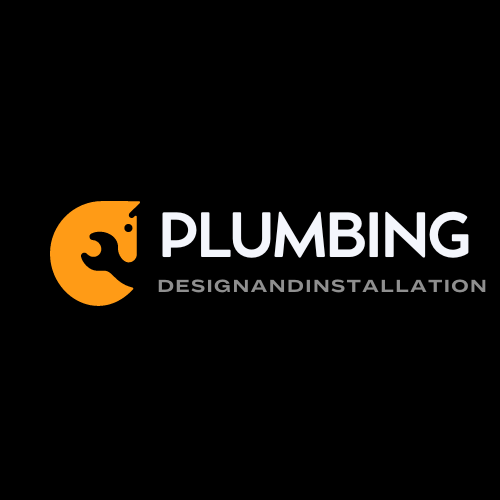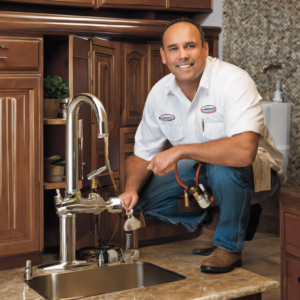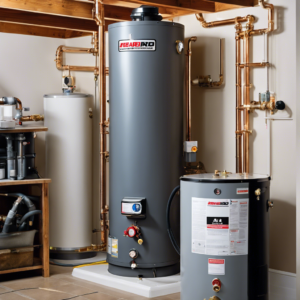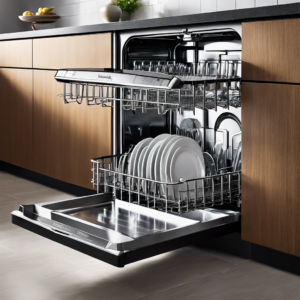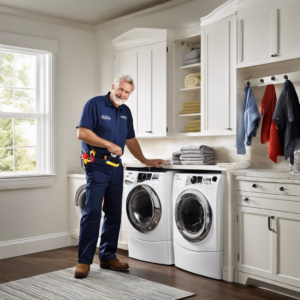

When you flush a toilet, you likely don’t think much about the mechanics behind what makes the water swirl and carry away the waste. But there are actually several different types of toilet flush systems that make this process happen in distinct ways.
Understanding the most common toilet flush system types, how they work, and their relative pros and cons can help you choose the right toilet for your bathroom and plumbing needs. We’ll explore the key flush system options:
- Gravity flush
- Pressure-assisted flush
- Double cyclone flush
- Compressed air flush
- Vacuum flush
Read on to learn how these different toilet flush systems get the job done!
Table of Contents
Table of Contents
Gravity Flush Toilet Systems
Gravity flush is the most common type of toilet flush system. As the name suggests, gravity flush toilets rely on the force of gravity and the siphoning action it creates to flush away waste and water.
How Gravity Flush Toilets Work
Gravity flush toilet systems contain a tank mounted above the bowl that holds fresh water. When you flush, the flush valve or flapper at the bottom of the tank opens and water rushes down into the bowl.
The fast surge of water entering the bowl creates a siphon effect that sucks all the contents out through the trapway and into the wastewater pipe. The siphoning action continues briefly even after the tank is empty, ensuring a thorough flush.
After flushing, the fill valve in the tank opens to refill the tank with fresh water until it reaches the correct water level again. This prepares the gravity flush system for the next flush.
Single Flush vs Dual Flush Gravity Toilets
Originally, most gravity flush toilets had a single flush option that used the same amount of water every time. But as concerns grew over wasting water, dual flush gravity toilets were designed.
Dual flush toilets have two flush options: a full flush for solid waste and a reduced, lighter flush for just liquid waste. The lighter flush uses much less water – around 0.8-1 gallon instead of 1.6 gallons. This helps conserve water.
Pros and Cons of Gravity Flush Toilets
Pros:
- Most affordable flush system option
- Simple, reliable, and widely available
- Dual flush models conserve water
- Easy for homeowners to maintain
Cons:
- Less powerful flush than pressure-assisted models
- More prone to clogs than pressure-assisted
- Single flush uses more water
Pressure-Assisted Flush Toilet Systems
Unlike gravity flush toilets, pressure-assisted flush toilets use compressed air to create an extremely powerful flush. The added force helps blast away stubborn waste.
How Pressure-Assisted Flush Toilets Work
Instead of just a tank, pressure-assisted toilets have a pressure vessel inside the tank. At the bottom of the pressure vessel is water, and above that is compressed air.
When flushed, the released pressurized air forces the water out of the bowl at very high pressure. This creates an extremely strong siphon effect that can move waste up to 15 feet or more vertically – much farther than a gravity flush toilet.
After the pressure vessel empties, the fill valve adds more water to the pressure vessel and an air compressor pump re-pressurizes the air pocket. This readies the system for the next flush.
Pros and Cons of Pressure-Assisted Flush Toilets
Pros:
- Extremely powerful flushing performance
- Less prone to clogs than gravity flush
- Can move waste further vertically
Cons:
- Noisier than other flush types
- Higher maintenance requirements
- Components may wear out faster
- Only available in a single flush option
Double Cyclone Flush Toilet Systems
The double cyclone flush system uses two nozzles inside the bowl to create a swirling “cyclone” effect when flushing. This helps rinse the bowl thoroughly.
How Double Cyclone Flush Toilets Work
Double cyclone flush toilets have two nozzles inside the rim of the bowl, angled to shoot water in a rotating circular pattern. The nozzles are fed from the toilet tank just like a gravity flush toilet.
When flushed, the water from the nozzles shoots into the bowl tangentially, creating a cyclonic swirling effect. This tornado-like swirl rinses the bowl thoroughly and then siphons down the trapway.
Some double cyclone models incorporate dual flush capabilities to reduce water usage. The cyclone effect helps clean the bowl well even with less water on light flushes.
Pros and Cons of Double Cyclone Flush Toilets
Pros:
- Creates a powerful swirling rinse effect
- Cleans bowl thoroughly with less water
- Dual flush options available
Cons:
- Cyclone effect requires precision engineering
- Nozzles can get clogged more easily
- Only some models available in North America
Compressed Air Flush Toilet Systems
Instead of water, compressed air flush toilets use a burst of pressurized air to create airflow that pulls waste into the trapway. This makes them a waterless flushing option.
How Compressed Air Flush Toilets Work
Compressed air flush toilets have a pressurized air vessel inside the unit below the bowl. When activated, a valve releases a jet of pressurized air that flows across the top of the bowl.
This rapid airflow creates a suction effect that pulls the waste down through the trapway and into the waste pipe. The forced air clears nearly all waste and liquid from the bowl.
After flushing, new air flows in to repressurize the air vessel for the next flush. A small amount of water may flow into the bowl to replenish the trapway water seal.
Pros and Cons of Compressed Air Flush Toilets
Pros:
- Uses little to no water, conserving resources
- Cleans bowl effectively
- Lower maintenance needs
Cons:
- Expensive to purchase and install
- Require power source for compressor
- Noisy flush and suction sounds
- Not widely available yet
Vacuum Flush Toilet Systems
Vacuum flush toilets employ vacuum suction to siphon waste into the sewer or holding tank after flushing. This allows efficient waste removal with very little water.
How Vacuum Flush Toilets Work
Vacuum flush toilets are connected to a vacuum waste collection tank or sewer interface using air-tight piping. When the toilet is flushed, both a vacuum valve and a water valve open briefly.
The vacuum valve draws air from the bowl and trapway, creating suction that swiftly siphons out the waste. At the same time, the water valve releases a small amount of water into the bowl, which rinses it and replenishes the trapway seal.
The waste is transported by the airflow through the vacuum piping to the central collection tank. No clogging risk exists since only airflows through the pipes.
Pros and Cons of Vacuum Flush Toilets
Pros:
- Uses only about 1 pint of water per flush
- Removes waste efficiently and powerfully
- Lower risk of clogs in the system
Cons:
- High installation cost for central vacuum system
- Requires electricity to run vacuum pump
Canister vs Gravity fed toilet
Canister Flush Toilets
- Also called pressure-assisted flush toilets
- Use a sealed canister in the tank containing air or nitrogen
- When flushed, compressed air pushes water out with high force
- Creates a very powerful siphon during flush
- Bowl is cleared more efficiently than gravity flush
- Uses 1.6 gallons per flush typically
Pros
- Stronger flush and siphon action
- Better clearance of waste in bowl
- Less likely to clog
Cons
- Noisier flush
- More expensive than gravity models
- Higher maintenance requirements
Gravity Fed Toilets
- Most common type of toilet
- Tank mounted above bowl holds water
- Flushing opens a flush valve, allowing gravity to pull water into bowl
- Water exiting tank starts siphon that clears bowl
- Uses 1.6 gallons per flush typically
Pros
- Inexpensive compared to other types
- Simple operation with less to break
- Easy for homeowners to maintain
- Quiet flush
Cons
- Weaker flush than pressure-assisted
- More prone to clogs
- Wastes more water if not dual-flush
Summary
- Pressure-assisted canister flush offers more power but costs more
- Gravity flush is more affordable and simpler, but has less flushing capability
- Dual-flush gravity models provide a good balance of efficiency and cost
Which Type of Toilet Flush System is Best?
So which is the best type of toilet flush system overall? Here are some key factors to consider:
Flushing Power – Pressure-assisted and vacuum flush toilets have the most powerful flushing capabilities, while gravity flush is the weakest. Power matters for moving waste and debris efficiently.
Water Efficiency – Vacuum and some dual flush toilets use the least water per flush. Gravity flush toilets use the most, unless they are dual flush models. Water conservation is key.
Cost – Gravity flush toilets are the most affordable, while vacuum systems are the most expensive to purchase and install. Pressure-assisted and compressed air also have higher costs.
Maintenance – Gravity flush systems are the easiest to maintain as a homeowner, requiring no specialized parts. Vacuum systems require upkeep of central vacuum equipment.
Noise Level – Gravity and cyclone flush toilets are the quietest choices. Pressure-assisted, compressed air, and vacuum flush systems make more noise during operation.
Availability – Gravity flush toilets are widely available from all retailers. Other types may need to be special ordered.
Given these factors, gravity flush toilets tend to provide the best overall value and performance for residential use. They are powerful enough, affordable, quiet, simple to maintain, and readily available.
For commercial applications, pressure-assisted and vacuum flush systems may be preferable for their increased flushing capability. But they come at a higher cost.
Common Toilet Flush System Problems and Solutions
Like any system, toilet flushes can develop issues that prevent proper operation. Here are some common toilet flush problems and how to address them:
Weak Flush – Low water level in tank, obstructed passages, leaky flapper seal, and clogged trapway or drain pipes can all cause weak flushing. Adjust fill valve, clear obstructions, replace flapper, and use plunger to clear clogs.
Toilet Won’t Stop Running – Faulty flush valve that doesn’t close fully after flushing causes continuous running. Replace flapper or flush valve assembly to stop.
Toilet Won’t Flush – If no water enters the bowl when flushed, there is no tank water supply. Check that shut-off valve is open and supply line is not kinked or clogged.
Flush Is Noisy – Debris stuck in trapway, worn flush valve, and issues with pressure-assisted mechanisms can cause extra noise. Clear debris, replace components.
Bowl Doesn’t Drain – Drain pipes may be clogged if bowl water doesn’t recede. Attempt plunging, then use auger snake or remove and clear pipes.
Leaking Toilet – Cracked tanks, worn out gaskets and washers, damaged pipes, and loose fittings can all lead to leaks. Identify source then replace needed gaskets, bolts, washers, or entire toilet.
Knowing the common toilet flush problems along with their likely fixes can help homeowners address issues quickly before greater damage is done. Don’t hesitate to contact a professional plumber for complex repairs.
FAQs About Toilet Flush Systems
What are the different types of toilet flush systems available?
There are 5 different types of toilet flush systems: gravity flush, pressure-assisted flush, dual flush, cyclone or tornado flush, and the flushometer valve system.
How does a gravity flush system work?
In a gravity flush system, water from the tank is released into the bowl, creating a siphon that pulls waste and water out of the toilet.
What is a dual flush system?
A dual flush system allows users to choose between a partial flush for liquid waste and a full flush for solid waste, helping to conserve water.
What is a tornado flush system?
A tornado flush system uses less water and features a powerful flushing mechanism that creates a tornado-like effect to thoroughly clean the toilet bowl.
How does a toilet fill valve work?
The toilet fill valve controls the water flowing into the toilet tank, refilling it after each flush to maintain the water level.
What is a flush mechanism?
The flush mechanism is the part of the toilet that is activated to force water into the toilet bowl for flushing waste down the drain.
What are some environmentally friendly flush systems?
Dual flush systems, tornado flush systems, and waterless or composting toilets are popular choices when it comes to environmentally friendly and water-saving options.
What are the common types of toilet flush valves?
The most common types of toilet flush valves include the flapper or tank ball valve and the flushometer valve system, which is commonly found in commercial settings.
What are some considerations for choosing a toilet flush system?
When choosing a toilet flush system, factors to consider include water efficiency, ease of maintenance, and the power of the flushing mechanism.
How does the siphoning action in a toilet work?
The siphoning effect happens due to gravity and atmospheric pressure. As water rushes out of the tank into the bowl, it displaces air and creates a partial vacuum. Atmospheric pressure then pushes water from the bowl into the vacated trapway to equalize, creating the siphon effect.
Why does my toilet get clogged?
Excessive paper, thick waste consistency, and objects like toys can obstruct the trapway and drainage pipes. Tree roots infiltrating pipes can also cause clogs over time. Avoid overuse of paper and only flush waste and toilet paper.
Do toilets use the majority of household water?
No, toilets account for just 19% of typical indoor water use. Showers and faucets actually use the most water. But upgrading to a more water efficient dual flush toilet can still save significant water over time.
What should I do if my toilet spews sewage when flushed?
Sewage backflows often occur due to venting issues or drain clogs. Close the toilet’s shut-off valve immediately and call a plumber. The clog needs to be mechanically cleared and the drain system inspected for faults before safely using the toilet again.
Why does my toilet make gurgling noises?
Gurgling sounds from a toilet are typically caused by air being sucked down the drain pipes along with waste. This happens when the trapway seal has dried out or venting problems occur. Adding water to the bowl or fixing vent issues will quiet gurgles.
Conclusion
With such a vital household function, it’s worth learning about the inner workings of the common toilet. Gravity flush, pressure-assisted, cyclone, compressed air, and vacuum flush systems each bring their own advantages and downsides in flushing performance, water efficiency, cost, and maintenance needs.
Understanding the fundamentals of how various toilet flush systems operate can help you select the type best suited to your bathroom, plumbing setup, and budget. Knowing some toilet troubleshooting tips also allows you to quickly address any flush problems that arise to keep your system functioning smoothly.
